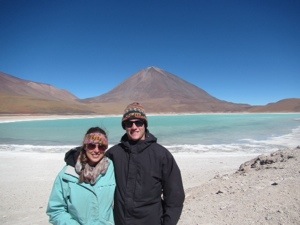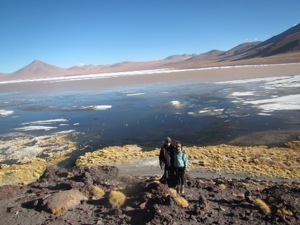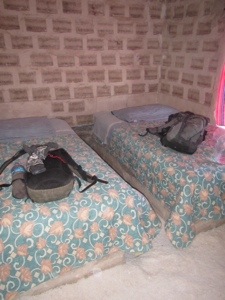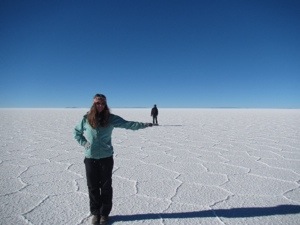After all of the horror stories that Ryan and I had read about the salt flats tour, we were pretty anxious when our time came to head there. The day began with a hostel pickup in San Pedro de Atacama, and after our van was full, we went to the Chilean exit point, which turned out to be around the corner from where our hostel was. We received our Chilean exit stamp, and then made our way about 45 minutes out of town to the Bolivian border, which was really just a house in the middle of the desert that said “Bolivia” on it. While receiving my entry stamp into Bolivia, I asked if there was a bathroom that I could use, and with a chuckle, the Bolivian border agent told me no, there was no bathroom there. Welcome to Bolivia!
Our anxiety continued to mount when we found out that we were taking the tour with a different company than we had been promised by our hostel, but the tour operator assured us our drivers were good before bidding us farewell and heading back to Chile. Our group divided into 2 jeeps, we packed our backpacks on the top of the jeep, and we were on our way. Our jeep consisted of Ryan and I and 3 English guys our age, who we referred to as the tripod for the rest of the tour. Our driver was a quiet Bolivian man, who wore a very tacky bucket hat, and had horrendous taste in music. Nevertheless, he drove slowly and took extremely good care of his jeep, which is much more important than good music.
As we began our tour, we headed off down the dusty desert road, making our first stop only a few kilometres past the Bolivian border crossing at a natural thermal bath, called Termas de Polques, that looked out over the beautiful aquamarine altiplano lake, Laguna Verde. The border had been absolutely freezing cold, and I wasn’t sure I would be able to strip down to my swim suit, but it turned out to be much warmer there and it was actually really nice to warm up with the splendid view.

As we continued our day, we climbed drastically in altitude, reaching a height of 5,000m above sea level by midday. The height was worth it, as we stopped to see the boiling mud, which is apparently hotter than lava, at the Sol de Mañana geysers, as well as another beautiful lake, Laguna Onda. We reached our accommodation for the night around 3pm, and were immediately served lunch. We were staying next to Laguna Colorado, which is a red altiplano lake, made red by the phytoplankton in the water. Without the chilling wind and the phytoplankton, the water would look the same as some of the other neighbouring altiplano lakes. Once we had finished lunch, we set off to get a view of Laguna Colorado. After walking for about 20 minutes, and heading up a small hill to get a view, Ryan and I were both out of breath, our hearts racing. We snapped a few photos of the lake and it’s inhabitant flamingos, and then made our way back slowly. By the time we got back, my head was throbbing, so I popped an Advil and took a nap. I woke up a few hours later freezing cold, although with a slightly less painful head. The altitude was definitely getting the best of me! We had a group dinner that evening and then headed to bed early, bundled up in multiple layers and under numerous blankets. I think it’s safe to say that this was the coldest sleep I’ve had to date.

The following morning, we were up early to have breakfast and pack our bags back on the jeep. Fortunately, I had slept in enough layers that it took very little effort to get ready for the day. We set out to some more not-so-fabulous tunes from our driver, heading north towards the salt flats. Although we had already spent a day driving, we were still very much in the desert. There area was desolate, with very little growth, and only the occasional llama was seen meandering around. Our first stop was at Valles de Rocas, which was left over volcanic rock in the middle of no where. We stopped to take photos of the well known tree rock (it looks like a tree, ie. the name), and climb across some of the bigger rocks. From there, we stopped at one final altiplano lake, where we went for a walk and had lunch, before heading onwards. We spent much of the day in the jeep driving, and although some of the roads were a bit bumpy, it was quite pleasant overall. I had expected to feel uncomfortable for much of the journey, and I had yet to feel that way.
Our final stop of the day was a view point of Volcan Oltague, which is an active volcano towering at nearly 6,000m above sea level. Although the view was nice, it seems that people have taken to using this stop as an outdoor toilet, and you have to be quite careful where you step. Not only is that disgusting, but it’s a shame to waste ruin a beautiful stop like that with human feces and toilet paper. Shortly after our last stop, we arrived in a small village called San Juan de Rosario, where we stopped for a snack and a beer. We tried the local quinoa beer there, and it was actually pretty tasty. One of the English lads wasn’t the biggest fan, but I quite enjoyed it.

Well into the evening, we arrived at our accommodation for the night, which was a hotel made of salt. We dumped our stuff and went with the owner to the nearby “museum”, which turned out to be a cave in the mountain with 3 very old skeletons (1,800 years old) and some old handicrafts. She asked us to leave a tip for the skeletons before leaving, making it one of the strangest experiences I’ve ever had. The awkward museum experience was worth it as we got our first glimpse of what was to come the following day: Salar de Uyuni. That evening, we all had the opportunity to take a hot shower, and we enjoyed a mediocre meal all together with some good wine. Fortunately, we had gone down to around 3,500m above sea level, and no one’s head was throbbing that evening. Unfortunately, the salt hotel was barely warmer than the night before, and Ryan and I ended up spooning on a twin bed for warmth.

On the final morning of our tour, we headed out around 5:30am, driving approximately 45 minutes on a make shift highway on the salt flats, until we arrived at Isla de Pescado (Isla Incahuasi), which is a giant island in the middle of the salt flats covered with cacti. We hiked up the mountain (panting) in time to catch the sun rise over the eastern mountains, casting an array of colours over the western mountains. Being on top of the cactus island gave us a good idea of just how big Salar de Uyuni is. Being the world’s largest salt flats, it stretches for over 12,000 square kilometres, made up of millions of hexigonical pieces of salt. Every which way I looked, all I saw was salt, and I have to say that this sunrise went straight to the top of the best sunrises I’ve seen so far in my lifetime.

We winded our way back down cactus island, taking in the giant cacti and letting wash over us, warming our freezing limbs. Upon arriving at the salt flats, we had breakfast and then made our way to a remote location to take photos on the salt. One of the reasons that the salt flats has become so popular is because of the perception photos that you can take. We took silly photos with a wine bottle, my hiking boot, a Pringle’s can, and a dinosaur. As well, we stood at different angles to make it look as though some of us were super small, while others were larger. We ended our strange photo shoot with the signature jumping shot, as well as a human star with all 5 of us. Salar de Uyuni was one of the things that I was looking forward to most in South America, and I have to admit that it didn’t disappoint. The flats themselves were breathtaking, and taking photos was just as fun as I had hoped it would be.

After nearly an hour of photo taking, we continued on our way, but by this point, most of us were satisfied with the trip. We made a quick stop to see the salt mountains, which are small mountains of salt piled up and waiting to be picked up to be made into commercialized salt. We also stopped in the tiny town of Colchani, where we watched 2 little Bolivian boys play and shopped for artisan goods from the salt flats. After lunch, we made our final stop at the train cemetery just outside of of the town of Uyuni. The trains were built in 1900 and used until 1935 to transport minerals to and from Calama in Chile. Although they still transport minerals to and from Calama by train, they use a more modern train system, leaving the unused trains to rust. Now, this area has become a popular stop for all salt flats tours, and you can climb around on the unused trains.
Moments later we arrived in the town of Uyuni, which is definitely nothing to write home about. After checking into a hostel, stripping off my many layers, and getting some much needed wifi, Ryan and I headed out for dinner with the tripod. We went to a pizza joint owned by an American guy, and had an enjoyable meal with a couple of bottles of well deserved wine!
So, did you leave the skeletons a tip?!? Hahaha
So, did you leave the skeletons a tip?!? Hahaha